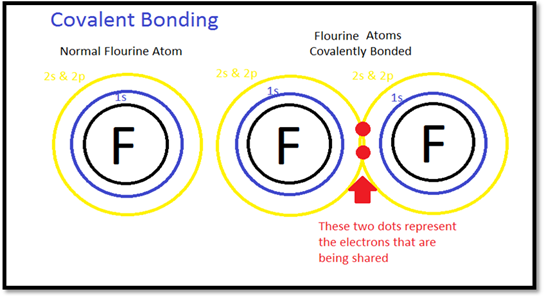
Concept explainers
Interpretation:
By using Lewis’s theory the covalent bond has to be explained.
Concept introduction:
Lewis theory is about
- Ionic bonding(complete transfer of electrons)
- Covalent bonding (sharing of electrons)
Answer to Problem 6.1QP
The Covalent bond is formed by the sharing of electron pair between two atoms by using Lewis’s theory.
Explanation of Solution
- Covalent Bonding
In covalent bonding the atoms share electrons equally, it means both the atoms have an equal share of pair of electrons in the bond, and this sharing of electrons creates a bond that is said to be covalent bond.
- Explain sharing of electron pair between two atoms:
Let us discuss an example for the formation of covalent bond in fluorine.

According to Lewis’s theory, covalent bond is formed by the sharing of electron pair between two atoms. As shown in figure, fluorine has two atoms each fluorine atom shares electrons to get electron pair which is represented in two dots. This electron pair forms the bond is known as covalent bond.
By using Lewis’s theory the covalent bond was explained.
Want to see more full solutions like this?
Chapter 6 Solutions
CHEMISTRY: ATOMS FIRST VOL 1 W/CONNECT
- For three simple molecules of your own choice, apply the rules for writing Lewis structures. Write your discussion as if you are explaining the method to someone who is not familiar with Lewis structures.arrow_forwardhy is there an octet rule (and what does actet mean) in writing Lewis structures?arrow_forwardDoes a Lewis structure tell which electrons came from which atoms? Explain.arrow_forward
 Introductory Chemistry: An Active Learning Approa...ChemistryISBN:9781305079250Author:Mark S. Cracolice, Ed PetersPublisher:Cengage Learning
Introductory Chemistry: An Active Learning Approa...ChemistryISBN:9781305079250Author:Mark S. Cracolice, Ed PetersPublisher:Cengage Learning Chemistry: Matter and ChangeChemistryISBN:9780078746376Author:Dinah Zike, Laurel Dingrando, Nicholas Hainen, Cheryl WistromPublisher:Glencoe/McGraw-Hill School Pub Co
Chemistry: Matter and ChangeChemistryISBN:9780078746376Author:Dinah Zike, Laurel Dingrando, Nicholas Hainen, Cheryl WistromPublisher:Glencoe/McGraw-Hill School Pub Co World of Chemistry, 3rd editionChemistryISBN:9781133109655Author:Steven S. Zumdahl, Susan L. Zumdahl, Donald J. DeCostePublisher:Brooks / Cole / Cengage Learning
World of Chemistry, 3rd editionChemistryISBN:9781133109655Author:Steven S. Zumdahl, Susan L. Zumdahl, Donald J. DeCostePublisher:Brooks / Cole / Cengage Learning Chemistry: The Molecular ScienceChemistryISBN:9781285199047Author:John W. Moore, Conrad L. StanitskiPublisher:Cengage Learning
Chemistry: The Molecular ScienceChemistryISBN:9781285199047Author:John W. Moore, Conrad L. StanitskiPublisher:Cengage Learning Living By Chemistry: First Edition TextbookChemistryISBN:9781559539418Author:Angelica StacyPublisher:MAC HIGHER
Living By Chemistry: First Edition TextbookChemistryISBN:9781559539418Author:Angelica StacyPublisher:MAC HIGHER





